Determining
Exposure
The DP-11 features an exposure meter display visible within the view field for
easy-to-read operation while viewing and focusing. Additionally, the selected shutter
speed and lens aperture settings are visible on either side of the meter display
to allow the photographer to check at a glance the camera settings in use.
 |
|
To determine the correct exposure with the DP-11
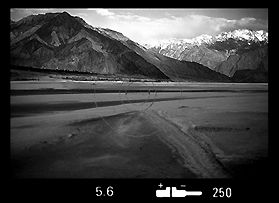 |
Switch on the meter by moving the film-advance lever to the 20° standoff position; with this action, the meter will swing to indicate the exposure condition of overexposure (needle to the left), correct exposure (needle to the center) or underexposure (needle to the right). If the needle moves to the left, increase the shutter speed or decrease the aperture until the needle is centered; if the needle remains at the right, decrease the shutter speed or increase the aperture until the needle is centered. |
<<<<<<<<--------Lancape ... Copyright © 2000. MCLau ® A beautiful scene in Pakistan. Hosted by: Malaysian Internet Resources
Metering Range
If the finder's meter needle fails to center, even after all Possible lens-aperture/shutter-speed combinations have been tried, then the available light is too bright or too dim for the meter's range. To correct this situation, several measures may be taken, as follows: Switch to a new film (either higher or lower ASA) that more closely matches the available light; mount a neutral density filter on the lens to decrease the light reaching the film plane; or use artificial lighting (i.e., an electronic flash unit) to increase subject illumination.
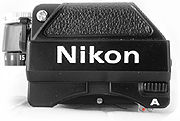 |
The DP-11 's metering range extends from EV 1 (f/1.4 at I second) to EV 17 (f/8.0 at 1/2000 second) with a 50mm f/1.4 lens and ASA 100 film. Nothing to shout about because Nikon has not improved the finder in anyway other than converting the original DP-1 with an AI metered prism. However, the DP-1 and the DP-11 has a greater ASA setting from 6-6400 instead of 12-6400 with other F2 metered finders. |
High-Contrast
Lighting Situations
When there are substantial brightness differences between the main subject and the
background, unimportant bright spots or dark spots can adversely influence the finder
reading, and thus the final exposure. To prevent under or overexposure of the main
subject under these shooting conditions, some corrective action must be taken to
ensure proper exposure of the main subject. Fortunately, the DP-11's center-weighted
TTL metering action simplifies adjustments, making for quicker camera operation and
more accurate final results.
 |
To compensate for an excessively bright or dark background, target the main subject in the center of the focusing screen while performing metering; this action ensures that the main emphasis of the meter reading will be on the chosen subject. Then, after completing aperture and shutter speed adjustments, recompose to the desired picture composition and make the exposure without readjusting the camera controls. |
For example, when shooting landscapes, it is often advisable to aim the camera slightly downward during exposure measurement to eliminate the effects of a bright expanse of sky; without such compensation, the landscape may appear underexposed in the final print.
Also, for backlit subjects, it may be necessary to move closer to the subject to ensure a proper reading. (See following pages for example photos.)
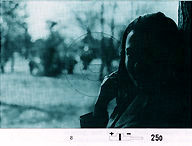 |
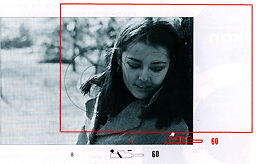 |
<<<<<<<<------ Metering with a
bright area in the center will cause underexposure of the main subject. For correct exposure, first measure the main subject; then, recompose and shoot. Note: Original images used in the Manual. |
With some Nikkor lenses, full-aperture exposure measurement is not possible, either because the lens has no automatic diaphragm, or because the lens does not couple with the finder's meter; with certain accessories, too, lens/ finder coupling is not possible, thus, preventing full aperture measurement. However, the DP-11's Photomic meter can still be used for exposure measurement via the stop-down method.
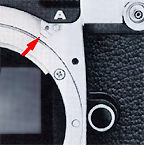 |
Before mounting the lens (or accessory) on the camera body, push the meter coupling lever up and to the right; with this action, the lever will remain locked up for stop-down exposure measurement (to release the lever after removing the lens/accessory, push the release to the right as described in "Coupling Lever Lock/Release Operation" section). After setting the finder, mount the lens or lens/accessory combination on the camera, switch on the meter by moving the film advance lever to the standoff position, and then set the controls for correct exposure as follows: |
For automatic diaphragm lenses with no coupling ridge, set the camera to the desired shutter speed; then, depress the depth-of-field preview button to stop down the lens diaphragm and, while holding the button depressed, adjust the aperture ring until the meter needle indicates correct exposure. Be sure to release the depth-of-field button prior to making the exposure.
For fixed-aperture lenses, such as Reflex-Nikkor lenses, simply adjust the shutter-speed selector until the meter needle indicates correct exposure. For convenience, shutter speeds can be set at intermediate settings in the 1/80 sec. to 1/2000 sec. speed range for precise exposures. The exposure can additionally be controlled via built-in or accessory ND filters.
For bellows units, extension rings and preset lenses, set the camera to the desired shutter speed; then, stop down the lens manually until the meter needle indicates correct exposure. Preset-type lenses include PC-Nikkor lenses.
EXPOSURE
COMPENSATION ADJUSTMENTS
Adjustments for Focusing Screens
Light transmission properties vary somewhat with focusing screen type, thus occasionally requiring exposure correction to compensate for the combined effects of the lens/screen combination in use.
To adjust the DP-11 for the indicated f/stop correction, lift and turn the ASA film-speed index ring until the ASA value for the film in use is aligned with the appropriate mark engraved on the ring. In the example figure shown, ASA 100 is aligned with the -1/2 mark to provide the correction required when using the Type C screen with a DP-11 Photomic Finder-equipped F2 Nikon camera and the Fisheye-Nikkor 6mm f/2.8 lens, as indicated in the table. (When "0" is indicated in the table, no compensation is required.)
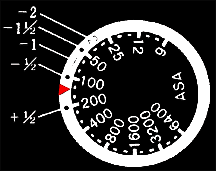 |
The numbers listed in the various blocks of the table on the left hand side denote the amount of correction necessary in f/stops. |
![]() = Exposure
measurement via full-aperture method. When using G-type and H-type screens, you cannot
use the stop-down method, because the exposure reading will be inaccurate.
= Exposure
measurement via full-aperture method. When using G-type and H-type screens, you cannot
use the stop-down method, because the exposure reading will be inaccurate.
![]() = Exposure measurement via stop-down
method.
= Exposure measurement via stop-down
method.
![]() = Exposure measurement not possible;
lens/screen combination permits only focusing operation.
= Exposure measurement not possible;
lens/screen combination permits only focusing operation.
Blank space indicates lens/screen combination cannot be used.
Adjustments for Film Compensation
Some exposure correction may be necessary when certain types of films are used for copying or photomicrography applications; the amount of correction required, however, will depend on the type of film and the specific application. The following table lists the exposure corrections in f/stops required for various film/shooting requirements. Compensation is possible by adjusting the shutter speed or the aperture by the indicated amount; also, compensation is possible by adjusting the ASA film speed index ring. In the example shown, the index ring is set so that the red mark is aligned with ASA 50; this setting is the correct position to achieve a one-stop increase in exposure (three scale graduations equal one stop) as required when performing photomicrography (see table) using ASA 100 panchromatic film.
|
Original/Type of Film |
Repro/Slide Copying |
|||
|
B/W/Color |
Letters/Figures on Light Background |
Letters/Figures on Dark Background |
Photomicrography |
|
|
Panchromatic Film for general use |
No Compensation required |
+ 1-1/2 Stop |
- 1/2 Stop |
+ 1 Stop |
CARE
AND HANDLING
Your F2A Photomic Finder DP-11 is durable. However, it also deserves the same care
you would give any precision instrument. Follow the simple precautions given below
and the finder will give you many years of dependable performance.
• Always attach
or remove the finder properly. Do not use excessive force in either case.
•
When
not in use, store the finder with a prism guard in a case. Avoid storing it where
it is liable to be exposed to excessive heat, cold or dampness.
• Avoid fingerprints
and dust on the prism surface. Brush away grit with a soft brush or use a rubber
lens blower. Do not use cloth or ordinary tissue. If smudges or fingerprints persist,
use a lens tissue sparingly dabbed with a professionally-recommended lens cleaner.
Wipe with a circular motion and gentle pressure. (Even an approved lens cleaner can
cause damage if it seeps into the prism mount.)
• When it is not
being used for a long period, check the finder periodically to see that it operates
properly.
• Before leaving
for a holiday, make a few trial exposures and allow at least two or three weeks'
time for film processing and making any needed repairs or adjustments.
Handy Accessories
Finder Eyecup
 |
The soft rubber finder eyecup screws directly onto the finder eyepiece to Prevent extraneous light from entering the viewfinder. When using an eyepiece correction lens with a finder eyecup, it is recommended to use the Nikkormat type eyecup. First, fit the lens into the eyecup in advance. Then screw the assembly onto the finder eyepiece. |
Eyepiece Correction Lenses
 |
The nine eyepiece correction lenses are designed to permit nearsighted and farsighted users to view and focus without their glasses. Available in -2, -3, -4, -5, 0, +0.5, +1, +2 and +3 diopters, each representing the combined dioptre of the lens and the finder. Simply screw into the finder eyepiece. |
Specifications:
Type of unit: Interchangeable eye level pentaprism type finder with built-in
exposure meter for F2 Nikon cameras; no modification or adjustment required for mounting
Exposure measurement: Thru-the-lens (TTL) Centre-Weighted system; both full-aperture
and stop-down measurement possible
 |
Exposure indication: Via meter needle display visible within finder; over- and underexposure markings provided; display also provided atop finder (See picture at left) with provision for battery power check indication. |
Metering
range: EV 1 to EV 17 (f/1.4 at 1 sec. to f/8 at 1/2000 sec.) with 50mm f/1.4
and ASA 100
Aperture coupling: f/I .2 - f/32; meter coupling lever provided for coupling
and automatic maximum aperture indexing with AI Nikkor lenses
Shutter speed coupling: 1- 1/2000 sec. via direct coupling
Meter ON switch: Built into camera's film-advance lever
Power source: Two 1.5V (button-cell type) silver-oxide batteries mounted in
camera body
Dimensions: 78mm x 43mm x 66mm
Weight: 220g
Accessories included: Plastic prism guard
| Previous | 2/2 Introduction, Metering and Operations
| Back | Main Index Page - Interchangeable Viewfinders
System
Accessories:
Motor
Drives
/ Prisms / Screens / Macro / Film
Backs
/ Flash
Other Accessories:
DS-1 / DS-2 / DS-12 / eyepiece / DH-1 / cases / Cable releases / Miscellaneous
| History
& Background
| Semi-FAQ | Various Features and Functions - 6 Parts |
| Message Board | for
your favourite Nikon
F2 Series SLR model(s)
| Message Board | for your Nikon Optics in a shared environment
| Message Board | Specifically for Dispose or Looking for Nikon/Nikkor Photographic
Equipment
| Back | to Main Index Page of Nikon F2 Series SLR models
| Back |
Main Index Page of Pictorial History of Nikon SLRs
 |
The Eyes of Nikon:- |
Fisheye-Nikkor Lenses - Circular | Full Frame | Ultrawides Lenses - 13mm15mm18mm20mm | Wideangle Lenses - 24mm28mm35mm |
Standard Lenses - 45mm 50mm 58mm | Telephoto Lenses - 85mm105mm135mm180mm & 200mm |
Super-Telephoto Lenses - 300mm 400mm 500mm 600mm 800mm 1200mm |
Special Application lenses:
Micro-Nikkor Lenses - 50mm~55mm -60mm 85mm -105mm 200mm Micro-Zoom 70-180mm
Perspective Control (PC) - 28mm 35mm PC-Micro 85mm
Dedicated Lenses for Nikon F3AF: AF 80mm f/2.8 | AF 200mm f/3.5 EDIF
Depth of Field Control (DC): 105mm 135mm
Medical Nikkor: 120mm 200mm
Reflex-Nikkor Lenses - 500mm 1000mm 2000mm
Others: Noct Nikkor | OP-Nikkor | UV Nikkor 55mm 105mm | Focusing Units | Bellows-Nikkor 105mm 135mm
Nikon Series E Lenses: 28mm35mm50mm100mm135mm | E-Series Zoom lenses: 36~72mm75~150mm70~210mm
MF Zoom-Nikkor Lenses: 25~50mm | 28~45mm | 28~50mm | 28~85mm | 35~70mm | 36~72mm E | 35~85mm | 35~105mm | 35~135mm |
35~200mm | 43~86mm | 50~135mm | 50~300mm | 70~210mm E | 75~150mm E | 80~200mm | 85~250mm |
100~300mm | 180~600mm | 200~400mm | 200~600mm | 360~1200mm | 1200~1700mm
Tele-Converters: TC-1 | TC-2 | TC-200 | TC-201 | TC-300 | TC-301 | TC-14 | TC-14A | TC-14B | TC-14C | TC-14E | TC-16 | TC-16A | TC-20E
![]()
Nikon F
| Nikon F2 |
Nikon
F3
| Nikon F4 |
Nikon
F5
| Nikon F6 |
Nikkormat / Nikomat |
Nikon FM
| Nikon FE/ FA | Nikon EM/FG/FG20 | Nikon Digital SLRs | Nikon - Other models
MIR Supports for Photographic Community: Various Message Boards/Community
Forums
Nikon
F-series|
Nikon
F2-series|
Nikon
F3-series|
Nikon F4-series| Nikon
F5-series|Nikkormat/Nikomat-series
Nikon FM-series|Nikon
FE-series|Nikon
FA|Nikon
Digital
SLR
series|Various
Nikon
Models|Nikkor
Optic
-shared
Others:- Free Trade Zone - Photography| Free Trade Zone - Business Community |Free To Zouk - Photographic Community
Apple's Mac Public Community Message Board | Windows based PC &
Apple/Mac
Public Community Trade Exchange Centre
Recommended links to understand
more technical details related to the Nikkor F-mount and production Serial Number:
http://rick_oleson.tripod.com/index-153.html by: my friend, Rick Oleson
http://www.zi.ku.dk/personal/lhhansen/photo/fmount.htm by: Hansen, Lars Holst
http://www.mir.com.my/rb/photography/hardwares/nikonfmount/lens2.htm
http://www.photosynthesis.co.nz/nikon/serialno.html
About this photographic site.
HOME - Photography in Malaysia |
Copyright © 2000. leofoo ®. MIR Web Development Team.
In
memory of my friend Com.
Augusto Staut,
Brazil, 1971-2000.
Credit: Chuck Hester, US for his patience, encouragement
and help to setup the various content in this site; Robert Johnson for some of his original
images on the F2H-MD appeared in this site; my ex-staff, KiaSu for his superb
3-D logo appeared in this Nikon F2 site; Marc Vorgers from Holland who
generously provide me with some of his images of F2AS; MCLau®, who has so much time with me to
re-edit the content in this site and not to mention buying a Nikon Coolpix 990 just
for this site. Keat Photo,
Kuala Lumpur for providing
their Nikon F2A to take some images for this site; again, Mr Edward Ngoh the
great camera collector who provides us his collection of F2AS with MD-2; hawkeye.photographic.com
for their images on the Speed Magny film backs; Sean Cranor for his image
on Nikon F2 25th Anniversary Model; Ted Wengelaar®, Holland for his continuous
flow of input on some of the early Nikon bodies; CYLeow ® , photo editor of the Star
newspaper, Malaysia for some of his images used in this site. Ms Rissa Chan, Sales manager from
Shriro Malaysia who has helped to provide some of the very useful input. HiuraShinsaku®,
Nikomat ML, Japan for some of his images on various F2 models; my staff, Wati, Maisa, Mai and my nephew, EEWyn®, who volunteered and helping me
did so many of the film scanning works. Contributing photographers or resellers:
Jen Siow, Foo KokKin, Arthur Teng, Mark Fallander, John
Ishii, Ed Hassel, YoonKi Kim, Jean-Louis, M.Dugentas (Dell Corner.com.), Mr "Arsenall" and a few images mailed
in from surfers with no appropriate reference to their origin. Dedicated to KU Yeo, just to express our mutual regrets over the outcome of
a recent corporate event. Made with a PowerMac, broadcast with a Redhat Linux powered server.
![]()
![]()
